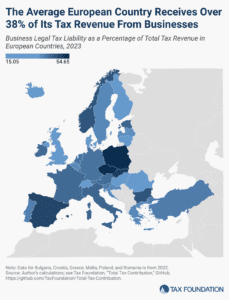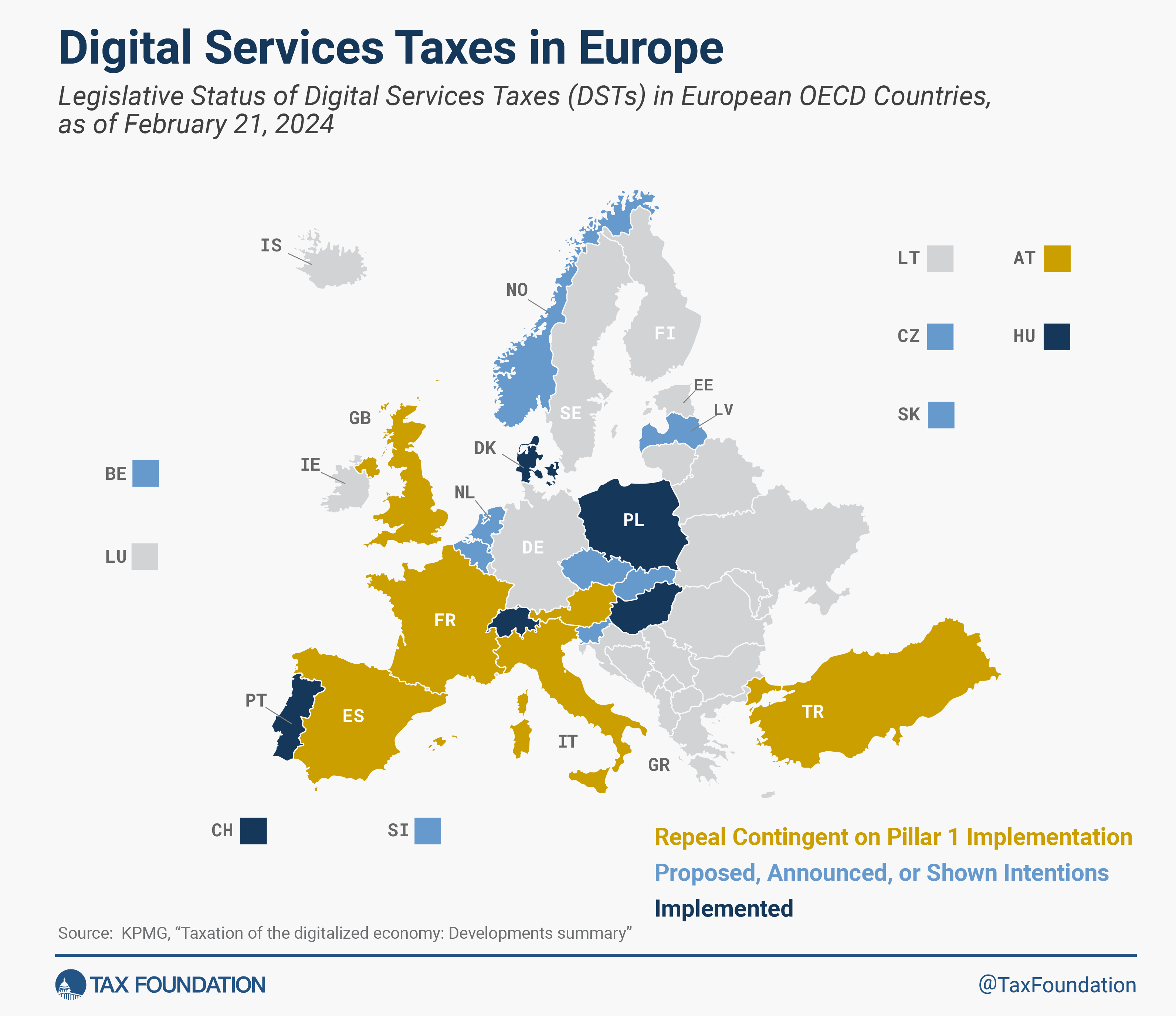
Digital Services Taxes in Europe, 2024
4 min readBy:Over the last few years, concerns have been raised that the existing international taxA tax is a mandatory payment or charge collected by local, state, and national governments from individuals or businesses to cover the costs of general government services, goods, and activities. system does not properly capture the digitalization of the economy. Under current international tax rules, multinationals generally pay corporate income taxA corporate income tax (CIT) is levied by federal and state governments on business profits. Many companies are not subject to the CIT because they are taxed as pass-through businesses, with income reportable under the individual income tax. where production occurs rather than where consumers or, specifically for the digital sector, users are located. However, some argue that through the digital economy, businesses (implicitly) derive income from users abroad but, without a physical presence, are not subject to corporate income tax in that foreign country.
To address these concerns, the Organisation for Economic Co-operation and Development (OECD) has been hosting negotiations with more than 140 countries to adapt the international tax system. The current proposal would require some of the world’s largest multinational businesses to pay some of their income taxes where their consumers are located. This proposal is referred to as Pillar One.
Pillar One would replace some existing norms for taxing multinationals and run counter to some policies that countries have put in place to tax digital companies in recent years. The most common form is a digital services tax (DST), which is a tax on selected gross revenue streams of large digital companies.
Because Pillar One is focused on changing where profits are taxed, including for many large digital companies, DSTs are expected to be repealed in a transition process anticipated to be completed by June 2024. However the OECD missed the March 31 deadline to reach an agreement on the text of Pillar One, casting doubts on when or if DSTs would ever be repealed. Additionally, in March 2024, the U.S. Treasury held a public hearing where a Joint Committee on Taxation staff report was discussed showing that Pillar One would result in a loss in U.S. federal receipts of $1.2 billion.
On October 21, 2021, a joint statement from Austria, France, Italy, Spain, the United Kingdom, and the United States laid out a plan to roll back DSTs and retaliatory tariffTariffs are taxes imposed by one country on goods imported from another country. Tariffs are trade barriers that raise prices, reduce available quantities of goods and services for US businesses and consumers, and create an economic burden on foreign exporters. threats once the Pillar One rules were implemented. On November 22, 2021, the U.S. Treasury announced that Turkey had agreed to the same terms. However, given the revised timeline for the adoption of the Pillar One agreement, in an updated joint statement, the participants agreed to extend the interim period to June 30, 2024.
The joint statement outlined a crediting approach to bridge between DST liability and new Pillar One tax liability for the companies in scope of both. This would be necessary for the transition expected to occur with minimal double taxationDouble taxation is when taxes are paid twice on the same dollar of income, regardless of whether that’s corporate or individual income. for the companies that would be liable under both Pillar One and current DSTs.
Apart from eliminating DSTs, an agreement on the treatment under Amount A of cross-border withholdingWithholding is the income an employer takes out of an employee’s paycheck and remits to the federal, state, and/or local government. It is calculated based on the amount of income earned, the taxpayer’s filing status, the number of allowances claimed, and any additional amount of the employee requests. taxes—often used by developing countries to tax the gross amount of transactions in related digital services—also needs to be reached. Additionally, the U.S. Treasury Department announced that it is negotiating the definition of DSTs as members of the U.S. Congress expressed concerns that Pillar One may not provide sufficient protection for all forms of digital taxes.
For now, as work on Pillar One continues (reflected in the most recent policy document), nine policies from eight different countries might be removed if Pillar One gets adopted.
However, these are not the only countries that may be impacted by the OECD agreement. About half of all European OECD countries have either announced, proposed, or implemented a DST. Because these taxes mainly impact U.S. companies and are thus perceived as discriminatory, the United States responded to the policies with retaliatory tariff threats, urging countries to abandon unilateral measures.
Austria, Denmark, France, Hungary, Italy, Poland, Portugal, Spain, Switzerland, Turkey, and the United Kingdom have implemented a DST. Belgium and the Czech Republic have published proposals to enact a DST, and Latvia, Norway, Slovakia, and Slovenia have either officially announced or shown intentions to implement such a tax.
The proposed and implemented DSTs differ significantly in their structure. For example, while Austria and Hungary only tax revenues from online advertising and Denmark’s DST applies only to streaming services, France’s tax baseThe tax base is the total amount of income, property, assets, consumption, transactions, or other economic activity subject to taxation by a tax authority. A narrow tax base is non-neutral and inefficient. A broad tax base reduces tax administration costs and allows more revenue to be raised at lower rates. is much broader, including revenues from the provision of a digital interface, targeted advertising, and the transmission of data collected about users for advertising purposes. The tax rates range from 1.5 percent in Poland to 7.5 percent in both Hungary and Turkey (although Hungary’s tax rate was reduced to 0 percent up to December 2024).
These DSTs were generally considered to be interim measures until an agreement could be reached at the OECD level. If such an agreement is reached, it will be important to monitor how countries change or repeal their DSTs. At the same time, the United Nations has added special provisions for income from automated digital services to the UN Model Tax Convention (see Article 12B), which would apply to treaty parties who agree to its inclusion.
Announced, Proposed, and Implemented Digital Services Taxes in Europe, as of March 2024
| Country | Tax Rate | Scope | Global Revenue Threshold | Domestic Revenue Threshold | Status |
|---|---|---|---|---|---|
| Austria (AT) | 5% | Online advertising | EUR 750 million (USD 801 million) | EUR 25 million (USD 27 million) | Implemented (Effective from January 1, 2020); joined statement on October 21, 2021, that repeal of the DST would be contingent on Pillar One implementation. |
| Belgium (BE) | 3% | · Selling of user data · Selling advertising space on a digital platform · Digital intermediation services facilitating the exchange of supplies of goods or services | EUR 750 million (USD 801 million) | EUR 5 million (USD 5.3 million) | Proposed (A DST was first introduced in January 2019 but was rejected in March 2019; an adjusted DST proposal was reintroduced in June 2020). Expected to introduce one if global consensus is not reached. |
| Czech Republic (CZ) | 5% | · Online advertising · Transmission of user data · Digital interface to facilitate the provision of supplies of goods and services among users | EUR 750 million (USD 801 million) | CZK 100 million (USD 4.2 million) | Proposed (There was a proposed amendment to reduce the tax rate from 7% to 5%. However, the discussion on the bill has stalled and there is support for a DST solution at the OECD level). |
| Denmark (DK) | 2% (3% surcharge) | On-demand, audio-visual media service providers | DKK 15 million (USD 2.2 million) | Implemented (Effective from January 1, 2024. There is an additional 3% surcharge for companies that invest less than 5% of their Danish revenues in Danish content. Additionally, the Finance Ministers of Denmark, Finland, and Sweden released a joint statement on digital tax, indicating that the digital and traditional economy should be taxed where value is created, and any solution reached should be a consensus-based OECD solution. However, the Danish Prime Minister announced Denmark's support to an EU-wide agreement on the DST controversy in case a global consensus is not reached). | |
| Finland (FI) | The Finance Ministers of Denmark, Finland, and Sweden released a joint statement on digital tax, indicating that the digital and traditional economy should be taxed where value is created, and any solution reached should be a consensus-based OECD solution. | ||||
| France (FR) | 3% | · Provision of a digital interface · Advertising services based on users’ data | EUR 750 million (USD 801 million) | EUR 25 million (USD 27 million) | Implemented (Retroactively applicable as of January 1, 2019. The 2020 DST collection was delayed to the end of 2020); joined statement on October 21, 2021, that repeal of the DST would be contingent on Pillar One implementation. |
| France (FR) | 1.20% | Paid and free access to recorded music and online music videos | EUR 20 million (USD 21.4 million) | Implemented (January 1, 2024. Due on amounts exceeding EUR 20 million). | |
| Hungary (HU) | 7.50% | Advertising revenue | HUF 100 million (USD 271,810) | Implemented (As a temporary measure, the advertisement tax rate has been reduced to 0%, effective from July 1, 2019, through December 31, 2024). | |
| Italy (IT) | 3% | · Advertising on a digital interface · Multilateral digital interface that allows users to buy/sell goods and services · Transmission of user data generated from using a digital interface | EUR 750 million (USD 801 million) | EUR 5.5 million (USD 5.9 million) | Implemented (Effective from January 1, 2020. In November 2022, there was a proposal to increase the DST rate from 3% to 6%); joined statement on October 21, 2021, that repeal of the DST would be contingent on Pillar One implementation. On March 20, 2024, the Italian Economy Minister announced that Italy might retain and modify its DST if efforts to implement the OECD's Pillar One do not pass. |
| Latvia (LV) | 3% | - | - | - | Announced/Shows Intention (The Latvian government commissioned a study to determine the increase of tax revenue based on the assumption that the country levies a 3% DST. However, no further action has been taken for now). |
| Netherlands (NL) | On October 24, 2023, the Dutch State Secretary wrote to the Dutch Parliament saying that an EU DST should be considered as an alternative to the OECD’s Pillar One, Amount A if a global agreement is not reached. | ||||
| Norway (NO) | - | - | - | - | Announced/Shows Intention (Norway plans to introduce a unilateral measure if the OECD does not reach a consensus solution; no announcements since the inclusive framework agreement). |
| Poland (PL) | 1.50% | Audiovisual media service and audiovisual commercial communication | - | - | Implemented (Effective from July 2020; there is a separate proposal to introduce a 7% levy on digital sector enterprises with a significant digital presence in the territory of Poland. Additionally, a 5% levy on advertisement revenues is also discussed). |
| Portugal (PT) | 4%, 1% | Audiovisual commercial communication on video-sharing platforms (4%), subscriptions for video-on-demand services | Implemented (Effective from February 2021; however, it is not applicable as regulation regarding assessment, collection and payment rules is pending). | ||
| Slovakia (SK) | - | - | - | - | Announced/Shows Intention (The Ministry of Finance opened a consultation on a proposal to introduce a DST on revenue of nonresidents from provision of services such as advertising, online platforms, and sale of user data. However, there were no further steps taken). |
| Slovenia (SI) | - | - | - | - | Announced/Shows Intention (The Ministry of Finance announced a government proposal to submit a draft bill to the National Assembly introducing a digital services tax by April 1, 2020; however, there has been no development so far). |
| Spain (ES) | 3% | · Online advertising services · Sale of online advertising · Sale of user data | EUR 750 million (USD 801 million) | EUR 3 million (USD 3.2 million) | Implemented (Effective from January 16, 2021); joined statement on October 21, 2021, that repeal of the DST would be contingent on Pillar One implementation. |
| Sweden (SE) | The Finance Ministers of Denmark, Finland, and Sweden released a joint statement on digital tax, indicating that the digital and traditional economy should be taxed where value is created, and any solution reached should be a consensus-based OECD solution. | ||||
| Switzerland (CH) | 4% | Gross income generated in Switzerland from streaming or television services | CHF 2.5 million (USD 2.75 million) | Implemented (Effective from January 1, 2024). | |
| Turkey (TR) | 7.50% | Online services including advertisements, sales of content, and paid services on social media websites | EUR 750 million (USD 801 million) | TRY 20 million (USD 615,896) | Implemented (Effective from March 1, 2020; the president can reduce the DST rate as low as 1% or increase it as much as 15%); agreed to same terms of the joint statement on October 21, 2021, that repeal of the DST would be contingent on Pillar One implementation. |
| United Kingdom (GB) | 2% | · Social media platforms · Internet search engine · Online marketplace | GBP 500 million (USD 623 million) | GBP 25 million (USD 31.2 million) | Implemented (Retroactively applicable as of April 1, 2020); joined statement on October 21, 2021, that repeal of the DST would be contingent on Pillar One implementation. |
Source: KPMG, “Taxation of the digitalized economy: Developments summary,” last updated Apr. 22, 2024, https://kpmg.com/kpmg-us/content/dam/kpmg/pdf/2023/digitalized-economy-taxation-developments-summary.pdf.
Stay informed on the tax policies impacting you.
Subscribe to get insights from our trusted experts delivered straight to your inbox.
SubscribePrevious Versions
-
Digital Services Taxes in Europe, 2022
7 min read -
Digital Services Taxes in Europe, 2021
7 min read -
Digital Services Taxes in Europe, 2019
4 min read






